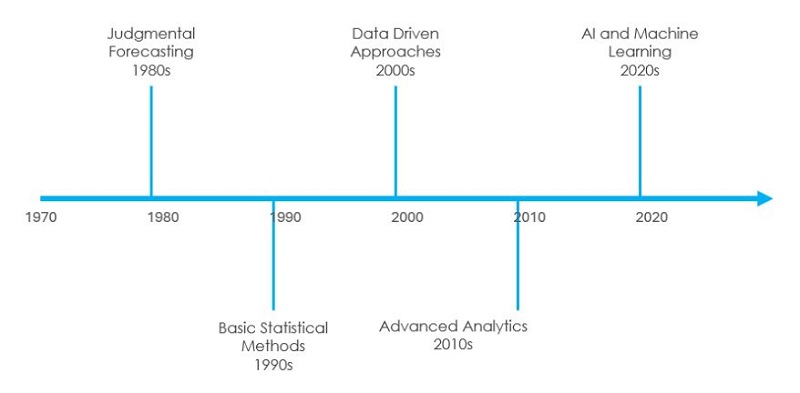A lot of things are changing. Market trends are becoming more unpredictable because of changing consumer preferences and the demand for more options when shopping and dining out. Unfortunately, overstocking isn’t the answer — food waste costs the planet about $1 trillion dollars a year. The best solution is to plan ahead by preparing for times of high demand. Aside from just guessing or pouring over your past sales by hand, the best way to approach this is demand forecasting. With the help of powerful algorithms, AI, and machine learning, you can optimize your use of supply chains and increase customer satisfaction during times of high demand. Before we let robots take over your kitchen, let’s explore more about how it works.
Challenges in Traditional Demand Forecasting
Demand forecasting isn’t exactly crystal ball-related. Even small restaurant owners can accomplish it with just their intuition. For example, in a college town, a restaurant can clearly predict that the busiest times of the year will be when school is in session. On a broader scale, you can get away with eyeballing that kind of forecasting. However, to become more efficient, reduce waste, and make customers happier, more precision is needed.
In the early 20th century, methods like moving averages, exponential smoothing, linear regression, and statistical models started making higher-scale operations possible. This was when traditional demand forecasting became much more serious. Rapid growth has been seen in this space in the past few decades alone. You’re likely using some of these methods by hand at your operation right now.
The introduction of computers greatly improved the capabilities of manual and traditional demand forecasting methods. However, these methods have limits. Manual demand forecasting depends on historical data and doesn’t account for real-time changes. If you perform an analysis on Wednesday and you get a bunch of sales on Thursday, you have to do the analysis over again to get an up-to-date forecast. If we can somehow break down those limitations, we can further streamline profits, reduce food waste, and make customers happier. That’s where AI comes in.
How AI and Machine Learning Improve Demand Forecasting
Your operation produces a treasure trove of data. That data is the backbone of your traditional demand forecasting methods. However, humans are terrible at pouring over vast amounts of data. Customer behavior, sales trends, and external factors (weather, holidays, local events) aren’t impossible to keep track of and account for, but unreasonable in real-time. A machine learning model can do it much more efficiently and accurately than you can when properly trained. Not only that, but AI demand forecasting models can leverage continuous learning to become even more effective at predicting your future demand. AI-based demand forecasting models can be tailored specifically for your restaurant’s needs as well with the best AI picture generator. For example, seasonality, promotions, and regional trends can all be accounted for.
Impact of AI Demand Forecasting on the Food & Beverage Industry
https://www.adobe.com/products/firefly/features/text-to-image.html
So, has predicting the future with robots done any good? Absolutely.
According to a study from the Sri Lanka Institute of Information Technology, machine learning and predictive modeling enables restaurants to reduce food waste. In their tests, the Institute was able to accurately predict the demand and material needs of numerous products at a restaurant using AI-based techniques. Since inventory management can be better optimized ahead of time with these techniques, food waste naturally is reduced as well.
The researchers found that the Stacking Regressor model was the most effective at forecasting demand for both food and ingredients compared to other tested algorithms. This model is actually a combination of various models. When restaurants use models in conjunction, more accurate results are possible. Intuitively, better product availability results in greater customer satisfaction.
Adopting AI Demand Forecasting for Your Business
So, now that you know how predicting the future can benefit your restaurant, how do you implement it effectively? Here’s your roadmap:
- High quality data: just like your well-prepared mise en place, setting up high quality data collection methods at places like your POS systems is critical to the success of machine learning systems.
- Choose model: there’s no single demand forecasting model that works best for every situation. You’ll need to choose the model that’s best for you. Experienced data scientists can help you make the right choice.
- Administrative training: train your administrative team on how to use the software frontend of the model so that you can make the most of the insights you gain from the forecasts.
- Monitor & adjust: continuously monitor the tool’s performance and make adjustments to improve accuracy as needed.
Whether you operate a restaurant, café, grocery store, online retailer, or something else entirely, understanding how this process applies to you is key to successfully implementing AI demand forecasting systems into your business. You might need to talk to consultants specializing in AI that can help you identify the best approach.
The Competitive Edge of AI in the Food and Beverage Industry
Given the competitive nature of the food and beverage industry, where profit margins are often narrow, and customer satisfaction is crucial, adopting AI and machine learning is a strategic move. These technologies not only streamline operations and reduce waste but also enhance customer experiences by ensuring product availability. Leveraging AI-based demand forecasting allows businesses to make data-driven decisions, improving efficiency, reducing costs, and boosting profitability.
As the industry continues to evolve, staying ahead requires embracing innovation. Integrating AI and machine learning into operations not only improves the bottom line but also distinguishes businesses from their competitors. Accurate demand forecasting and optimized inventory management offer greater flexibility and responsiveness to market changes. In this dynamic landscape, adopting advanced technologies is not just optional — it’s essential for long-term success and sustainability.







